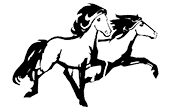Last weekend me (Lukka) and our older son (Heimir, 12 yo), went on a horse trekking arranged by a good horse club in the Skagafjordur area. The trekking lasted 3 days and we rode about 120 kilometers (ca. 75 miles). We’ve been about 40 riders (there of 9 kids that are ca. 12-13 years old, and the oldest rider was a 76 year old horse farmer) with about 170 horses total. Each rider has 2 + horses, and then when one gets tired we turn it loose in the herd and saddle up another horse. We ride very fast, but stop frequently for 15-60 minutes, so people can chat and saddle up new horses when needed and grab a bite when needed, and the horses can rest, drink, and be sociable. On a trip there are not much differences between the needs of a man and a horse, but the tie of friendship and solidarity between people and horses becomes strong.
On Friday we went from Solheimagerdi in Skagafjordur, up through the area Kjalki, and then into the wilderness, by many century old horse trails over the canyon Merkigil, after that we stayed in an old farm house which is a mountain cabin today. On that day we were driving loose horses, and they were like pearls on a string when we went over the canyon.
On Saturday we took hand horses (ponied extra horses) but not loose horses and went on a ride into the grassy and desolate/remote mountain valley Austurdalur, where there are herds of horses and sheep roaming in the summertime. Each rider had 2-3 horses to ride on for that day, and we rode 40-50 km on that day (we split into 2 groups in the end), and back to the cabin in the evening.
On Sunday we took all the horses and drove the extra horses in a herd, took a different route back over a narrow bridge over the Jokulsargljufur canyon, and back through the area Lytingsstadarhreppur. The horses were on the way back home now, and going fast.
Heimir was going for the first time on such a very long ride and did superbly, helped with driving the herd, denied to have any tired muscles, and hung on to his horses for dear life when needed 🙂 We had 5 horses, 7-14 year old strong working horses, two of them were green to such trekking but they did amazingly well.
When we breed good show horses in Iceland, the Icelanders are breeding good working horses at the same time. Out of the 5 horses we took on the trip, all of them are after 1. prize fathers, two of them after Landsmot winners, One of them after a double world champion winnter, and Heimir took his Elva, the same mare as he competed on at Landsmot and several other competitions this summer (her father is honorary price winner at Landsmot). The horses that go on such trekkings also preferably have to be strong, courageous, willing to please, smooth to ride on, love to tolt, be very sure on their feet, easy to catch, pony super easily, be easy going around other horses and on the ground, have good hooves and strong legs, ground tie naturally and take all sorts of natural obstacles in a stride. This is what has shaped the Icelandic horse, and this is what will keep on shaping the Icelandic horse in Iceland. The riders have to be tough, sit stuck when going fast in uneven landscape (this was no baby-sitting ride), cooperative, used to long days in the saddle, used to read the horses minds and understand keeping the herd of 120 horses under control (often at high speed), and happiness, being jolly and enjoying singing comes naturally when horse trekking with people from Skagafjordur 🙂
Many of the pictures are blurred, some of them taken on a bad camera in my phone, others blurred as I was going fast on horse back while photographing (or both). But you get the athmosphere 🙂
